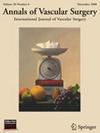自体上臂静脉移植物在下肢分流术中的应用效果。
IF 1.6
4区 医学
Q3 PERIPHERAL VASCULAR DISEASE
引用次数: 0
摘要
背景:采用自体导管进行的下肢旁路手术具有良好的通畅性和肢体保留性。这通常是通过单段大隐静脉(GSV)进行的,但对于没有可用GSV的患者可能需要其他选择。本研究介绍了我们的经验,利用臂静脉作为另一种自体导管的患者接受下肢搭桥手术。方法:对2009年1月至2023年7月在退伍军人事务医疗中心行下肢静脉搭桥术的外周动脉疾病(PAD)患者进行单中心回顾性研究。主要结局是无截肢生存(AFS)和主要肢体不良事件(MALE)。次要结局包括术后并发症,如术后手术部位感染、总住院时间、30天死亡率和计划外30天再入院。结果:2009年1月至2023年6月,42例GSV不足患者行下肢旁路手术。所有手术均在男性中进行(n=42, 100%)。中位年龄为67岁(四分位间距62 -71岁)。9例(21.4%)治疗跛行,21例(50%)治疗组织丢失,12例(28.6%)治疗静息性疼痛。大多数涉及绕过未成熟的目标(n= 39,93%)。导管组成包括单片(n=19, 45%)、两片(n=19, 45%)或3片(n=4, 10%)臂静脉复合移植物。AFS中位数为3.86年(IQR 1.19-6.65年)。5例(15.6%)患者需要大截肢。到男性的中位时间为0.88年(IQR为0.23-1.69年)。30天死亡率为2.4% (n=1)。术后并发症包括手术部位感染9例(21.4%),血肿3例(7.1%),早期移植物血栓1例(2.4%),创面裂开1例(2.4%),淋巴漏1例(2.4%)。中位住院时间为6天(IQR 3.3-9.5天)。结论:对于没有足够GSV的患者,臂静脉是一种可行的替代下肢动脉旁路的自体导管。本文章由计算机程序翻译,如有差异,请以英文原文为准。
Outcomes After Utilization of Autogenous Arm Vein Grafts for Lower Extremity Bypasses
Background
Lower extremity bypasses performed with autogernous conduit have superior patency and limb salvage. This is often performed with single segment great saphenous vein (GSV), but other options may be required for patients without available GSV. This study presents our experience utilizing arm veins as an alternative autogenous conduit for patients undergoing lower extremity bypass procedures.
Methods
A single-center retrospective study of patients at a Veterans Affairs Medical Center with peripheral arterial disease (PAD) who underwent lower extremity bypass with arm vein between January 2009 and July 2023 was performed. The primary outcomes were amputation-free survival (AFS) and major adverse limb event (MALE). Secondary outcomes include postoperative complications, such as postoperative surgical site infection, total hospital length of stay, 30-day mortality, and unplanned 30-day readmission.
Results
From January 2009 to June 2023, there were 42 lower extremity bypasses performed in patients who possessed inadequate GSV. All procedures were performed in men (n = 42, 100%). The median age was 67 years (interquartile range (IQR) 62–71 years). Nine procedures (21.4%) were performed for claudication, 21 (50%) for tissue loss, and 12 (28.6%) for rest pain. The majority involved bypassing to infrageniculate targets (n = 39, 93%). Conduit composition included single (n = 19, 45%), two-piece (n = 19, 45%), or three-piece (n = 4, 10%) composite grafts with arm vein. The median AFS was 3.86 years (IQR 1.19–6.65 years). Five patients required major amputation (15.6%). The median time to MALE was 0.88 years (IQR 0.23–1.69 years). Overall, 30-day mortality was 2.4% (n = 1). Postoperative complications included surgical site infection in 9 patients (21.4%), hematoma in 3 patients (7.1%), early graft thrombosis in one patient (2.4%), wound dehiscence in one patient (2.4%), and a lymph leak in one patient (2.4%). The median length of stay was 6 days (IQR 3.3–9.5 days).
Conclusion
Arm vein is a viable alternative autogenous conduit for lower extremity arterial bypasses in patients without adequate GSV.
求助全文
通过发布文献求助,成功后即可免费获取论文全文。
去求助
来源期刊
CiteScore
3.00
自引率
13.30%
发文量
603
审稿时长
50 days
期刊介绍:
Annals of Vascular Surgery, published eight times a year, invites original manuscripts reporting clinical and experimental work in vascular surgery for peer review. Articles may be submitted for the following sections of the journal:
Clinical Research (reports of clinical series, new drug or medical device trials)
Basic Science Research (new investigations, experimental work)
Case Reports (reports on a limited series of patients)
General Reviews (scholarly review of the existing literature on a relevant topic)
Developments in Endovascular and Endoscopic Surgery
Selected Techniques (technical maneuvers)
Historical Notes (interesting vignettes from the early days of vascular surgery)
Editorials/Correspondence

 求助内容:
求助内容: 应助结果提醒方式:
应助结果提醒方式:


